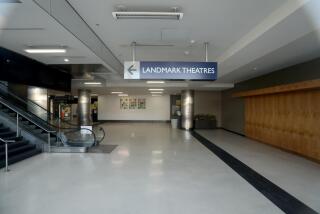Landmark Honors for San Diego Center
- Share via
SAN DIEGO — Glistening this weekend in anticipation of being dedicated as a national landmark at noon Monday is the San Diego County Administration Center, 1600 Pacific Highway. Marked by a 150-foot tower, the center brims with architectural and historical interest.
It was 50 years ago, on July 16, 1938, that the classically massed, well-detailed, richly decorated center was dedicated in a flag-waving ceremony by President Franklin D. Roosevelt to house city and county government offices.
Designed and built under the federal Public Works Administration, the center was hailed by Roosevelt as an outstanding example of civic architecture and as a symbol of the efforts of both San Diego and the nation to overcome the Depression of the 1930s.
On a less chauvinistic note, the center was also cited at the time as an “engineering feat” for its intricate steel and reinforced-concrete construction, designed to meet the most rigorous of earthquake standards. With 20,000 cubic yards of concrete and 1,521 steel pilings forming a complex system of lateral stresses, this is one landmark building that is not going to be demolished easily.
When it was constructed, the style of the center was labeled Beaux Arts because of its classical references and balanced facade. However, over the years, architectural historians have categorized such buildings as PWA Moderne, after the federal program and its adaptation of the streamlined modernistic style with a touch here and there of Art Deco that bloomed in the 1930s.
In style, the county center is distinguished by symmetrical massing, its vertically patterned windows and smooth-surfaced volumes accented by richly detailed ornamentation. This includes about 40 cast-cement figures of eagles on the exterior and a marvelous display of glazed decorative tiles, both inside and out.
Whatever the style, program and motive, the design, construction and decoration of the project display a rare craftsmanship and obvious pride, from the harbor-side siting and extensive landscaping to the use of wood and tile work in the interiors. Note the decorative terrazzo flooring depicting the great seal of California on the floor of the central lobby. Such detailing in civic structures is just not done anymore.
If the central tower, topped by a modest setback, seems a little stubby and out of proportion with the center’s 544-foot frontage, this is because it was originally designed to rise 225 feet--75 feet or about seven stories higher than its present 150 feet. However, the design had to be altered because of concern that the tower might interfere with air traffic in and out of the military and commercial airports nearby.
Lending the building some regional character are the select arched doorways and windows, the red-tile roof of the four-story wings and the rich display of glazed decorative tiles, the latter hinting at the tone of the Spanish Renaissance-styled landmark California Tower in Balboa Park. Perhaps not incidentally, the tower, rendered in tile, can be seen in the panel over the west entrance of the center.
Scheduled to attend the landmark designation ceremony Monday is Samuel Hamill, who in 1935 at the age of 32 was one of the principal designers of the center. Other architects involved in the project included William Templeton Johnson, Richard Requa and Louis Gill. Landscape architects were Harriett Wimmer and Joe Yamada. Most of the tile work was designed by Chicago architect Jesse Stanton.
As for the stylized, representative sculpture of the woman carrying water that dominates the approach to the west entrance of the center, it was the work of local artist Donal Hord. Known as “Guardian of Water,” the 23-foot sculpture is supposedly symbolic of the region’s dependence on water from the mountains and its tie to the sea.
Carved in 1939 from local granite under yet another Roosevelt-inspired program, this one an arts project, the sculpture is another example of the city’s dependence on federal largess at that time.
Political attitudes in the conservative-leaning region may have changed since then, but happily the art and architecture of the period perseveres.
The building is open to the public weekdays 8 a.m. to 5 p.m., except holidays.
More to Read
Sign up for Essential California
The most important California stories and recommendations in your inbox every morning.
You may occasionally receive promotional content from the Los Angeles Times.










